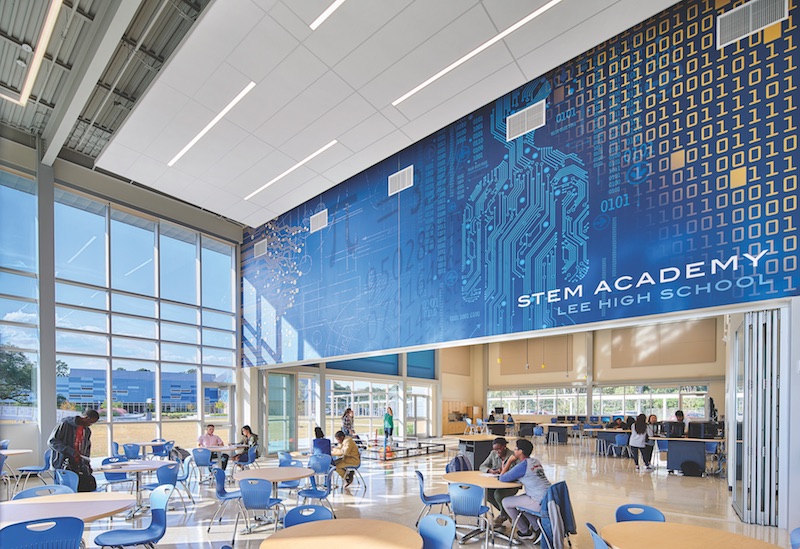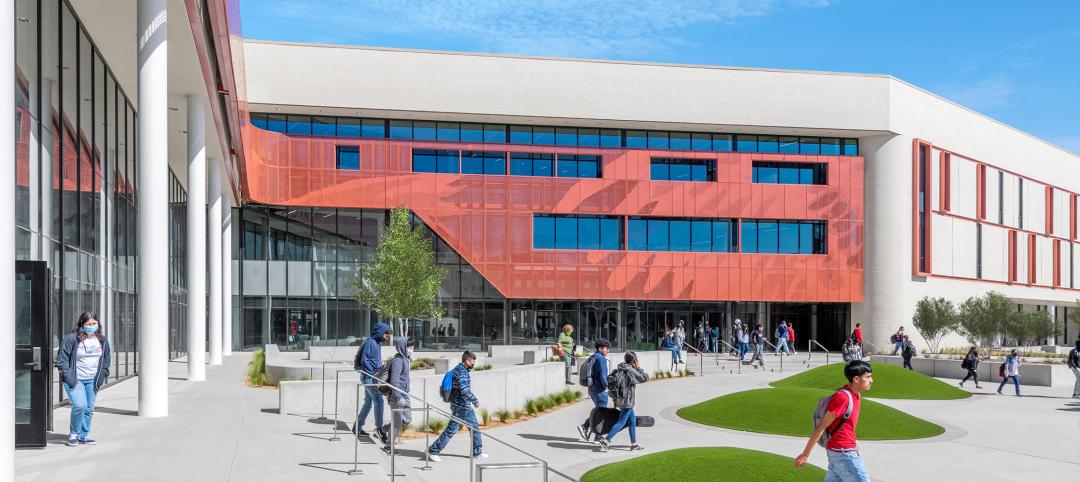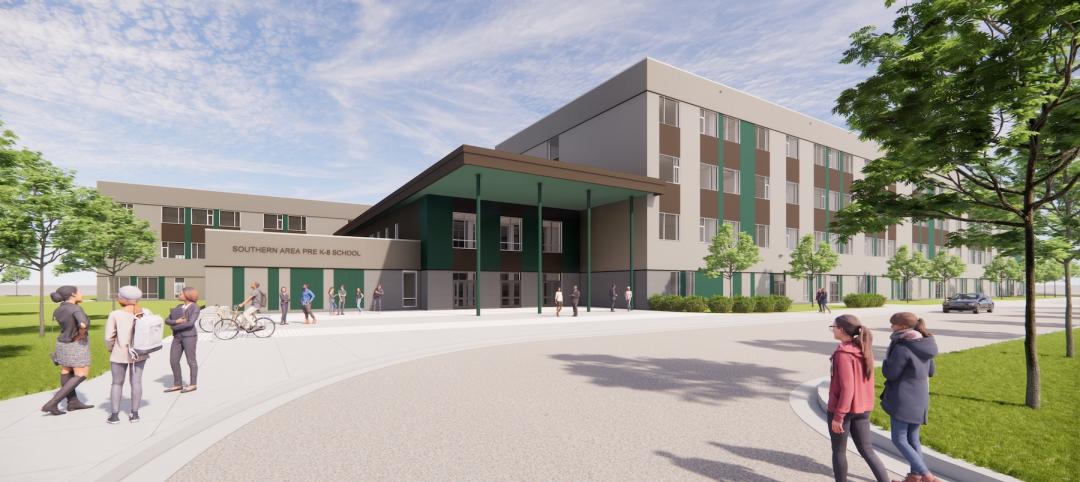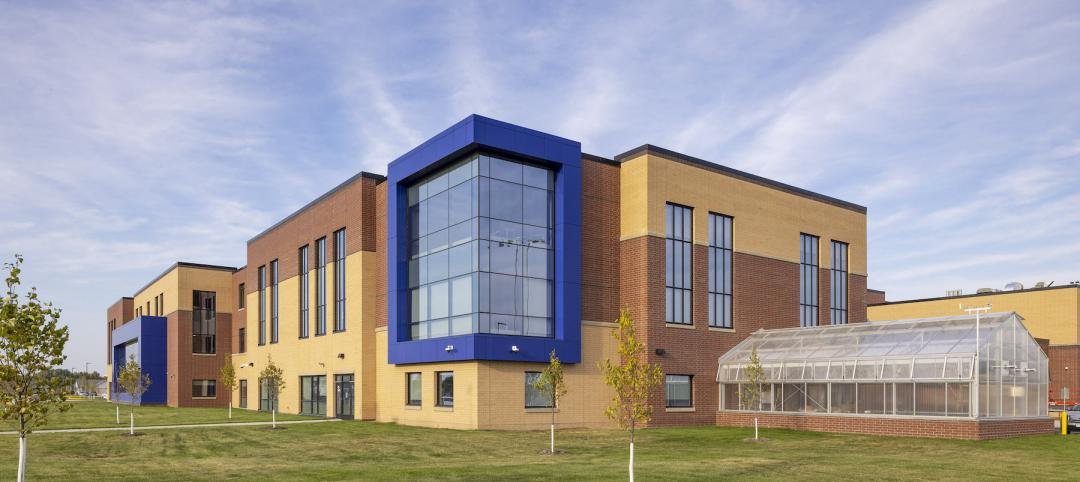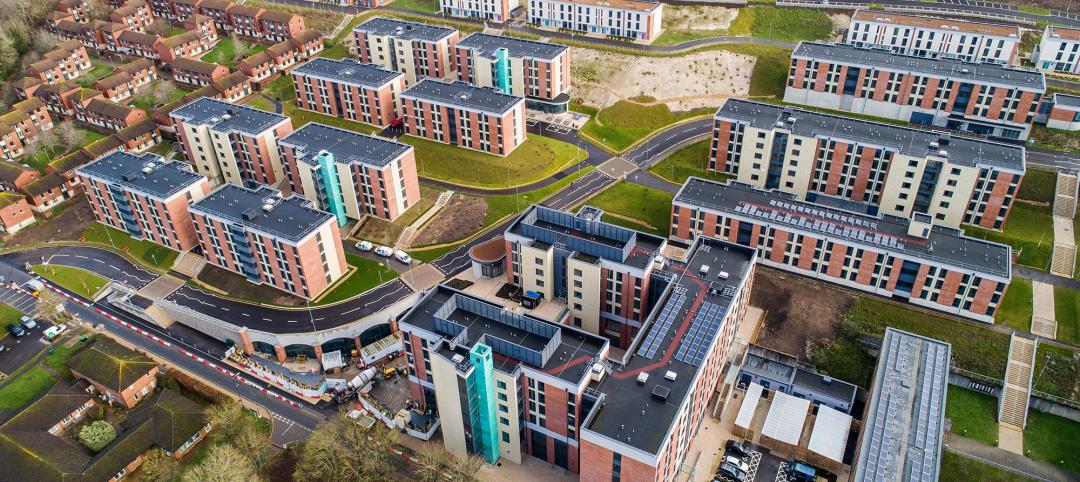Next fall, a $74 million, 335,000-sf addition to Shakopee (Minn.) High School should be completed, doubling the school’s size to accommodate a growing population and the relocation of ninth graders from a former junior high.
Vaughn Dierks, Partner and Educational Planner with Wold Architects and Engineers, says this expansion will provide students the chance to rethink how they approach learning through the creation of six separate academies within the school: arts and communications, business and entrepreneurship, engineering and manufacturing, health sciences, human services, and science and technology.
Some long-term K-12 trends—like beefing up safety and security, and designing for more natural light and outdoor learning space—are still in vogue. But districts and their communities also want schools to focus on encouraging hands-on, collaborative, real-world learning experiences.
“Today, there’s much more of a career push early on,” says Tom Oehler, Vice President and Senior Principal with Stantec. “Bridging core academics and cognitive skill development with applied learning, career, and technical education helps students uncover their passion, while empowering them with a comprehensive skill set for a successful future.”
This trend manifests itself in different ways. In Houston, the $47 million Sterling Aviation High School, which opened last year, offers a unique career magnet program. The 237,000-sf school has its own full-size hangar, flight simulators, and more than a dozen aircraft engines. “The school is technology rich, community focused, and flexible enough to evolve as pedagogies do,” says Oehler.
Another Stantec project is Lee Elementary School, in the Coppell (Texas) Independent School District, near Austin. Rather than organize classes by grades, the school groups students from kindergarten to grade five into learning “houses,” supported by six teachers who engage with all of the students. “The community approach focuses on needs rather than age,” explains Oehler.
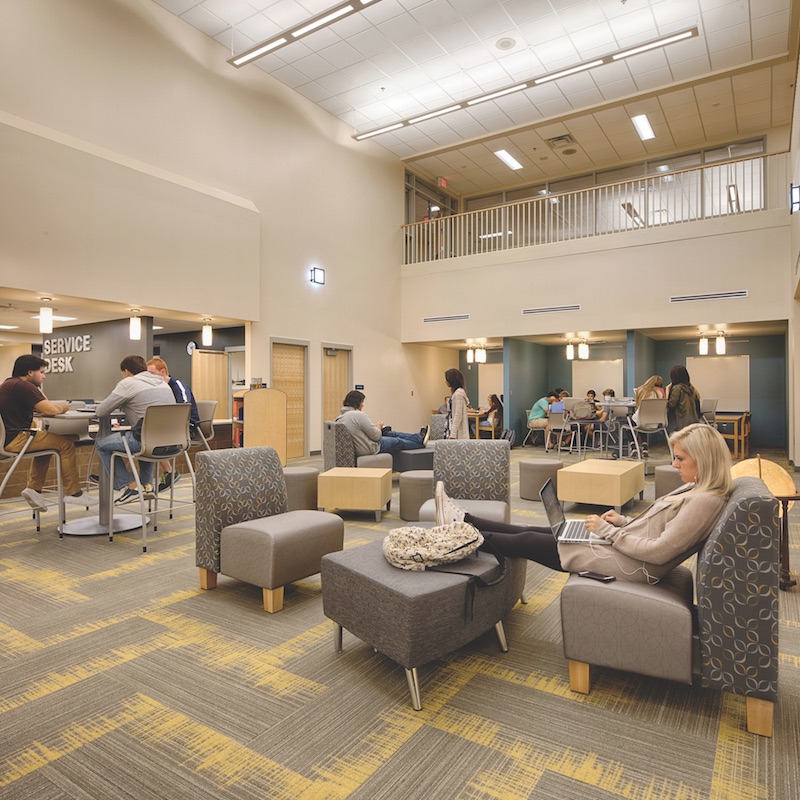 Instead of a library, Hermantown High School, near Duluth, Minn., has a wired media center. Books are available in a high-density storage area. Photo: Steve Silverman Photography.
Instead of a library, Hermantown High School, near Duluth, Minn., has a wired media center. Books are available in a high-density storage area. Photo: Steve Silverman Photography.
teaching skills, not just facts
Jim French, FAIA, DLR Group’s K-12 Education Global Sector Leader, says clients are asking for “spatial diversity or plurality.” Such a setting provides students with access to spaces and resources that allow them to engage in an open-ended project or unit of curriculum “where students are learning more skills than facts.”
Lee Magnet High School, East Baton Rouge, La., for which DLR provided planning and architectural services, is designed for a generation of student entrepreneurs. The 26-acre campus is comprised of three, 400-student academies where students work in 3,000-sf tech-ready “studios” that offer personalized and customizable learning in STEM, biomedical, and digital arts. A separate commons building houses shared functions for the academies.
What AEC firms and their clients constantly ask themselves is whether schools are flexible enough to adjust to changing educational needs. “The biggest trend is probably the ability to adapt to a trend,” says Joe Kunkle, AIA, PE, LEED AP, Principal and Healthcare, Commercial, and Education Department Manager for SSOE.
Flexibility must extend beyond the physical building to encompass technology, which “remains a priority,” says Ron Simoneau, Vice President–New England for Shawmut Design and Construction. That’s especially true of wireless technology.
K-12 schools are also reallocating square footage away from hallways and lockers to free up more collaborative space. Nowhere has this been more evident than in school libraries, which are evolving into media centers that foster collaboration.
Hermantown High School, near Duluth, Minn., for which Wold completed a $39 million, 134,000-sf addition last year, doesn’t have a traditional library. Books are in an on-demand high-density storage area. Media specialists and technology staff assist students from common information desks located in the middle of all classrooms and labs. The environment is casual and wired, says Dierks.
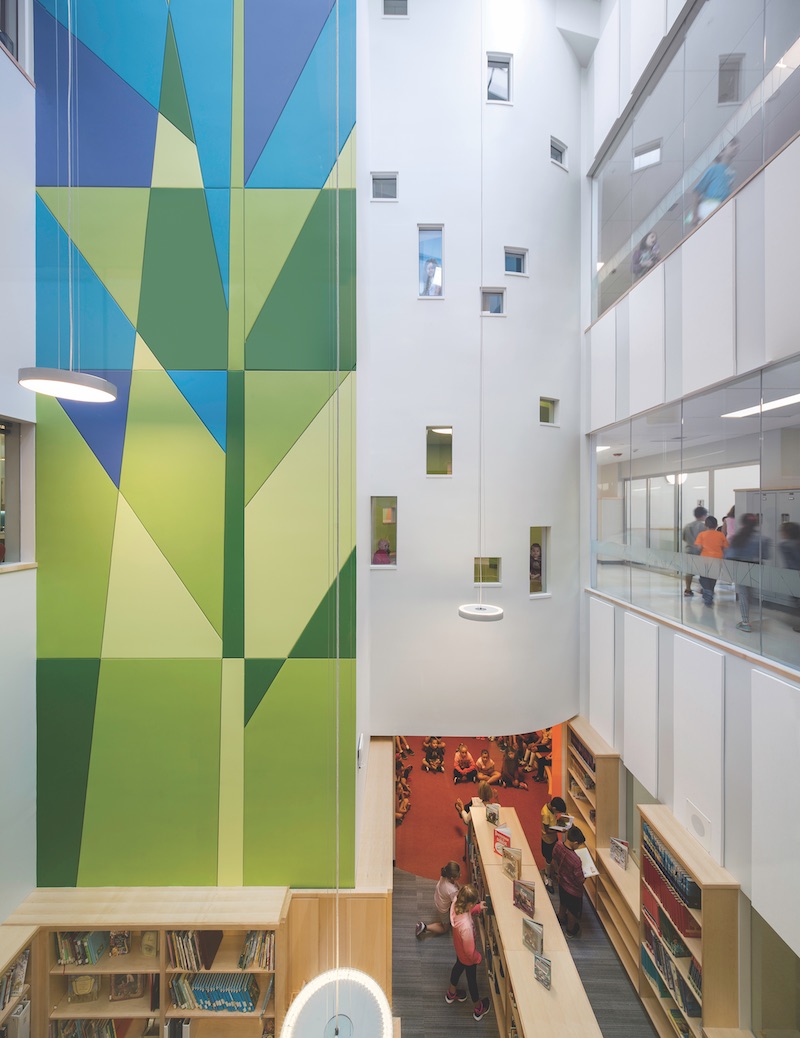 The 132,500-sf Woodland Elementary School, which sits on 20 acres in Milford, Mass., replaces an older school at the same site. Each floor is dedicated to a grade, grouped into three smaller clusters of six classrooms with a learning commons that includes a media space, amphitheater, circular storytelling rooms, and project areas. Photo: Shawmut Design and Construction.
The 132,500-sf Woodland Elementary School, which sits on 20 acres in Milford, Mass., replaces an older school at the same site. Each floor is dedicated to a grade, grouped into three smaller clusters of six classrooms with a learning commons that includes a media space, amphitheater, circular storytelling rooms, and project areas. Photo: Shawmut Design and Construction.
new ways to find the money
Funding is a perennial worry for any construction project, but more so for K-12 districts that rely primarily on sales taxes or bond issues. More districts are also investigating public-private partnerships to finance school projects, says Susan Tully, Gilbane Building Co.’s K-12 Center for Excellence Market Leader.
California and Texas are singled out as states where voters and investors see value in building and renovating schools. Shawmut’s Simoneau notes that, since 2004, the Massachusetts State Building Authority has invested more than $12.5 billion to subsidize 31–80% of a local district’s costs for K-12 renovation or construction.
Local school enrollment trends appear to be the factor that determines whether districts build new or renovate. “Communities are making case-by-case judgments on what’s best,” says Larry Casey, LEED AP, Skanska USA’s Executive Vice President and Chief Strategy and Markets Officer. He says more districts now employ CM at risk and design-build delivery methods to better ensure budget and scheduling certainties.
ALSO SEE: BD+C Giants 300 K-12 rankings
Top 90 K-12 architecture firms
Top 80 K-12 construction firms
New construction seems more prevalent in localities where enrollment is going up. Where enrollment is stable or declining, renovation is usually the better path. In either situation, a complete replacement is “a difficult sell,” says SSOE’s Kunkle. Over the past five years, his firm has been involved in four K-12 district rebuilds, whose aggregate construction costs exceeded $280 million. Of the roughly 30 buildings SSOE worked on for those projects, only six were new construction.
Labor shortages stymie projects
On the whole, AEC firms are bullish about their prospects in K-12. “In most areas of the country, the K-12 market remains strong or steady,” says Tully. Where bonds have passed, “it will be a busy year,” adds Casey.
DLR’s French foresees more adaptive-reuse opportunities. Wold’s Dierks says that, given this sector’s aging infrastructure, renovation—the majority of his firm’s work right now—should remain solid.
But there are concerns, especially for larger projects, starting with labor shortages in construction trades. SSOE’s Kunkle says his firm is seeing more K-12 projects whose scope is “focused” or “limited" due to labor shortfalls.
SEE ALL 2017 GIANTS 300 RANKINGS
Related Stories
Designers | Jan 3, 2024
Designing better built environments for a neurodiverse world
For most of human history, design has mostly considered “typical users” who are fully able-bodied without clinical or emotional disabilities. The problem with this approach is that it offers a limited perspective on how space can positively or negatively influence someone based on their physical, mental, and sensory abilities.
Education Facilities | Nov 9, 2023
Oakland schools’ central kitchen cooks up lessons along with 30,000 meals daily
CAW Architects recently completed a facility for the Oakland, Calif., school district that feeds students and teaches them how to grow, harvest, and cook produce grown onsite. The production kitchen at the Unified School District Central Kitchen, Instructional Farm, and Education Center, (“The Center”) prepares and distributes about 30,000 meals a day for district schools lacking their own kitchens.
Products and Materials | Oct 31, 2023
Top building products for October 2023
BD+C Editors break down 15 of the top building products this month, from structural round timber to air handling units.
Giants 400 | Oct 30, 2023
Top 170 K-12 School Architecture Firms for 2023
PBK Architects, Huckabee, DLR Group, VLK Architects, and Stantec top BD+C's ranking of the nation's largest K-12 school building architecture and architecture/engineering (AE) firms for 2023, as reported in Building Design+Construction's 2023 Giants 400 Report.
Giants 400 | Oct 30, 2023
Top 100 K-12 School Construction Firms for 2023
CORE Construction, Gilbane, Balfour Beatty, Skanska USA, and Adolfson & Peterson top BD+C's ranking of the nation's largest K-12 school building contractors and construction management (CM) firms for 2023, as reported in Building Design+Construction's 2023 Giants 400 Report.
Giants 400 | Oct 30, 2023
Top 80 K-12 School Engineering Firms for 2023
AECOM, CMTA, Jacobs, WSP, and IMEG head BD+C's ranking of the nation's largest K-12 school building engineering and engineering/architecture (EA) firms for 2023, as reported in Building Design+Construction's 2023 Giants 400 Report.
K-12 Schools | Oct 21, 2023
The Blueprint Schools Program in Maryland reins in construction time and cost
This collaborative P3 is also committed to expanding participation of small and minority businesses.
K-12 Schools | Oct 4, 2023
New high school in Minnesota provides career pathways for students
This 90-acre school campus also features myriad sports facilities.
K-12 Schools | Oct 2, 2023
4 design strategies for successful K-12 magnet schools
Clark Nexsen's Donna Francis, AIA, Principal, and Becky Brady, AIA, share four reasons why diverse K-12 magnet schools require diverse design.
Contractors | Sep 25, 2023
Balfour Beatty expands its operations in Tampa Bay, Fla.
Balfour Beatty is expanding its leading construction operations into the Tampa Bay area offering specialized and expert services to deliver premier projects along Florida’s Gulf Coast.


